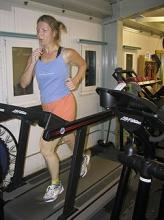By improving the risk factors of weight, exercise, and alcohol consumption, women could reduce their 20-year risk of breast cancer by more than 4%, depending on age and other risk factors.
A new risk model suggests that a risk reduction of 1.6% could prevent 16,000 cases of breast cancer in a population of 1 million women. On an individual basis, a 55-year-old woman with the most nonmodifiable risk factors could see the biggest benefit, an absolute risk reduction of 4.4%
Even younger women at the highest risk of breast cancer could reduce their risk over 20 years by more than 3% if they optimally improved all three modifiable risk factors, Elisabetta Petracci, Ph.D., reported in the June 24 issue of the Journal of the National Cancer Institute.
 Kristan Hutchison (Property of National Science Foundation)/ (Antarctic Photo Library (Image link)), via Wikimedia Commons .
Kristan Hutchison (Property of National Science Foundation)/ (Antarctic Photo Library (Image link)), via Wikimedia Commons .
Kristan Hutchison (Property of National Science Foundation)/ (Antarctic Photo Library (Image link)), via Wikimedia Commons.By increasing physical activity, cutting back on alcohol, and maintaining an ideal weight, women could reduce their risk of breast cancer.
"The absolute risk model developed in this study could help clinicians make decisions about implementing interventions to reduce a patient’s exposure to modifiable risk factors, thereby reducing their absolute risk of breast cancer," wrote Dr. Petracci and her colleagues (J. Natl. Cancer Inst. 2011;103:1-12). "Because programs to encourage less alcohol consumption, increase leisure activity, and encourage some weight control are likely to be safe, they can be widely administered."
The researchers began their model with data from an Italian breast cancer case-control study of 2,569 cases and 2,588 controls who were followed during 1991-1994. To compute absolute risk, they employed 5-year, age-specific, breast cancer incidence rates from the Florence Cancer Registry in 1989-1993. Rates were based on an estimated 2006 population of 1,190,516 women.
Another Italian study provided a validation cohort consisting of 10,083 women who were followed during 1998-2004. This study collected demographic information as well as information on anthropomorphic characteristics, age, physical activity, reproductive history, diet and lifestyle, and a family history of breast cancer.
The team considered all of the risk factors and calculated the 10- and 20-year risk of breast cancer as well as the 10- and 20-year absolute risk reductions if the three modifiable factors improved optimally. They performed the calculations in each study cohort, then averaged the results to confirm the possible reductions.
The risk reduction model divided its cohort into nine profiles, ranging from a young, low-risk group to an older, high-risk group. Including the above characteristics, the model also took into account educational level, alcohol consumption, ages at menarche and first live birth, and the number of lifetime breast biopsies.
In the entire population, if women aged 45 years improved all three modifiable risk factors, they could reduce the overall 20-year risk by 1.4%. The population-based risk for 65-year-olds could drop by 1.6%. The risk reduction is less in the older women because they generally had more favorable nonmodifiable risk factors, the authors noted.
On an individual basis, a 45-year-old woman with a positive family history could decrease her absolute 20-year risk by 2.7%; the reduction could be 3.2% in a woman aged 65 years.
For a younger woman with the highest nonmodifiable risk factors (only 10% of the population), optimally improving exercise, weight, and drinking could reduce the 10-year risk by 1.6% and the 20-year risk by 3.2%. A 55-year-old could reduce her 10-year risk by 2.4% and her 20-year risk by 4.4%. The oldest women in this category could reduce their 10-year risk by 2.5% and their 20-year risk by 4.1%.
But these numbers also need to be viewed in the context of a large population, the authors noted. Although an overall reduction of 1.6% would save 16,000 cases annually in a population of 1 million women, it would save only 2,560 cases annually in the 8% of postmenopausal women who have a family history of cancer.
Despite these limitations, the authors wrote, "Calculations of reductions in absolute risk using our model potentially provide additional perspective in the possible benefits of such prevention strategies."
This research was supported by the Division of Cancer Epidemiology and Genetics at the National Cancer Institute, and the Associazione Italiana per la Ricerca sul Cancro. The investigators did not report any conflicts of interest. Dr. Helzlsouer said that she had no relevant financial disclosures.

